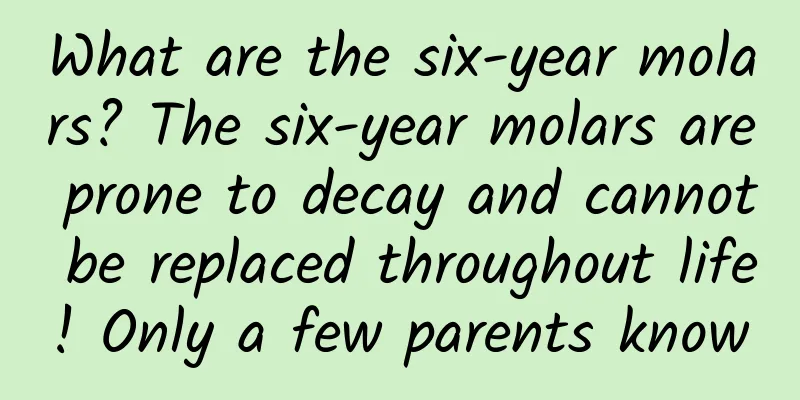What are the six-year molars? The six-year molars are prone to decay and cannot be replaced throughout life! Only a few parents know

|
What is the sixth molar? When a child is 6 or 7 years old, a large tooth may grow behind the last deciduous tooth on the upper and lower jaws. Medically, it is called the first permanent molar. Because it erupts around the age of 6, it is also called the "six-year molar". It does not replace any deciduous teeth, but is a molar, and is at the end of the deciduous teeth. It has a great role! It is the main permanent tooth for chewing food. When the deciduous teeth are replaced by permanent teeth, the "six-year molars" are of great significance for maintaining the position relationship between the upper and lower jaws, and also play an important role in maintaining the normal shape of the entire maxillofacial region. Why is the caries rate of sixth-anterior molars high? The fourth national oral health epidemiological survey shows that the caries prevalence rate of permanent teeth in 12-year-old children in my country is 34.5% (of which more than 90% are pit and fissure caries). The caries prevalence rate of deciduous teeth in 5-year-old children is 70.9%, and the caries prevalence rate among children is on the rise. Data show that 60% of caries occur in the sixth molars. The reasons are as follows: "Six-year molars" are the first permanent molars that grow out when children are 6 years old. Because they erupt early, they are exposed to the caries-causing environment of the oral cavity for the longest time and are most likely to be attacked by bacteria. In addition, "six-year molars" have an uneven biting surface, and the cracks and fissures on them are easy to hide bacteria. Because "six-year molars" erupt quietly behind the second deciduous molars, they are not easy to attract people's attention. Some people even mistake them for deciduous molars and ignore their importance. Pits and fissures are defects in the development of tooth enamel. They are more common on the apical, buccal, and lingual surfaces of the back teeth. The shapes of pits and fissures are complex and vary in depth. There is often a low-calcified enamel plate at the bottom of the groove, which lacks self-cleaning function. Under the pressure of chewing, food debris is pressed into the pits and fissures. It is difficult to completely clean the pits and fissures by brushing teeth or rinsing the mouth, so it is easy to develop caries. Doctors remind: Six-year molars are the first molars to erupt. Many parents mistake them for deciduous teeth and think they can be replaced. This is actually a misunderstanding! Once the six-year molars are decayed, they not only cause pain, but also affect appetite, chewing and digestion functions, and have an adverse effect on children's growth and development. If not treated in time, pulpitis, alveolar abscess, mandibular osteomyelitis, etc. may also occur. In severe cases, they may induce systemic diseases such as rheumatoid arthritis, heart disease, nephritis, and endocarditis. How to care for the sixth molars? It is found in clinical practice that most of the dental diseases in adults are new types of dental diseases that occur after childhood caries. Therefore, it is very necessary to prevent caries in the sixth-anniversary teeth during the caries-sensitive period, such as between the ages of 5 and 9, in order to prevent future dental diseases. NO.1 Pay attention to dental hygiene Starting from the age of 2, teach your baby to rinse his mouth after meals and brush his teeth in the morning and evening. Starting from the age of 3, gradually teach your child to brush his teeth correctly every day. NO.2 Regular inspection In the two or three years after your baby's teeth erupt, you should try to have a checkup every six months to ensure early detection and early treatment. NO.3 Repair caries in time If your baby has severe tooth decay and the pulp is necrotic, do not remove the tooth easily. Ask the doctor to perform root canal treatment and then retain it. Severely damaged teeth can be repaired with metal crowns. If it is really impossible to retain, you should get a denture as soon as possible after extraction to fill the gap. NO.4 Put on "protective clothing" for the sixth molars At present, in addition to mastering the correct brushing method and using fluoride toothpaste, the most effective way to protect the "six-year-old teeth" is "pit and fissure sealing". It seals the above cracks and fissures to reduce the chance of food residues and bacteria attaching, and puts on "protective clothing" for the six-year-old teeth to prevent caries. Pit and fissure sealing, also known as "pit and fissure sealing", is an effective method of preventing tooth decay by applying a layer of adhesive resin to the pits and fissures of the cheek, buccal or lingual surface without removing tooth tissue. It protects the tooth enamel from erosion by bacteria and metabolic products, thereby preventing the occurrence of tooth decay. If your baby has severe tooth decay and the pulp is necrotic, do not remove the tooth easily. Ask the doctor to perform root canal treatment and then retain it. Severely damaged teeth can be repaired with metal crowns. If it is really impossible to retain, you should get a denture as soon as possible after extraction to fill the gap. The best age for pit and fissure sealing ● Primary molars··········3~4 years old ● First permanent molar·······6~7 years old ● Second permanent teeth········11~13 years old Note: The closed age limit may be relaxed for children with disabilities. Doctors remind: Some sealants can last for more than a year on the tooth surface and can be resealed after they fall off. Since the pit and fissure sealants will wear away with chewing activities after completion, it is recommended to have regular checkups and reseal if there is wear. |
<<: It was lukewarm in previous years, but this year it’s so hard to get a shot?
Recommend
Who is suitable for medical abortion?
Maybe recently many couples often have unexpected...
Can IUD be used for emergency contraception?
IUD insertion is a relatively common contraceptiv...
Is fake tofu also a treasure? It would be a shame not to eat these 5 kinds of fake tofu!
When you search for tofu, you'll often find &...
When is the best time to eat mochi? How to make mochi at home
Nowadays, the pressure of life is relatively high...
What should I do if there is too much amniotic fluid?
For pregnant women, too much or too little amniot...
Being hypnotized = absolute obedience? You are still too naive!
In the study of psychology, it is often mentioned...
Will vulvar furuncle heal on its own?
Some diseases can actually be cured by our body&#...
How to treat a weak female constitution?
In life, it is very common for women to be physic...
Decidua discharge after medical abortion
If you can have medical abortion between the 35th...
Stanford’s latest research: Be careful of “cliff-like aging” at 44 and 60 years old!
The original meaning of "衰" refers to a...
What causes stomach pain during pregnancy?
The most concerning issue for pregnant women is t...
Can pelvic inflammatory disease be cured?
Pelvic inflammatory disease is a gynecological di...
How to deal with vulvar itching and scabs?
Vulva itching and scabs are very harmful to the v...
Master feeding tips to ensure safe feeding
As the aging population in my country becomes inc...









